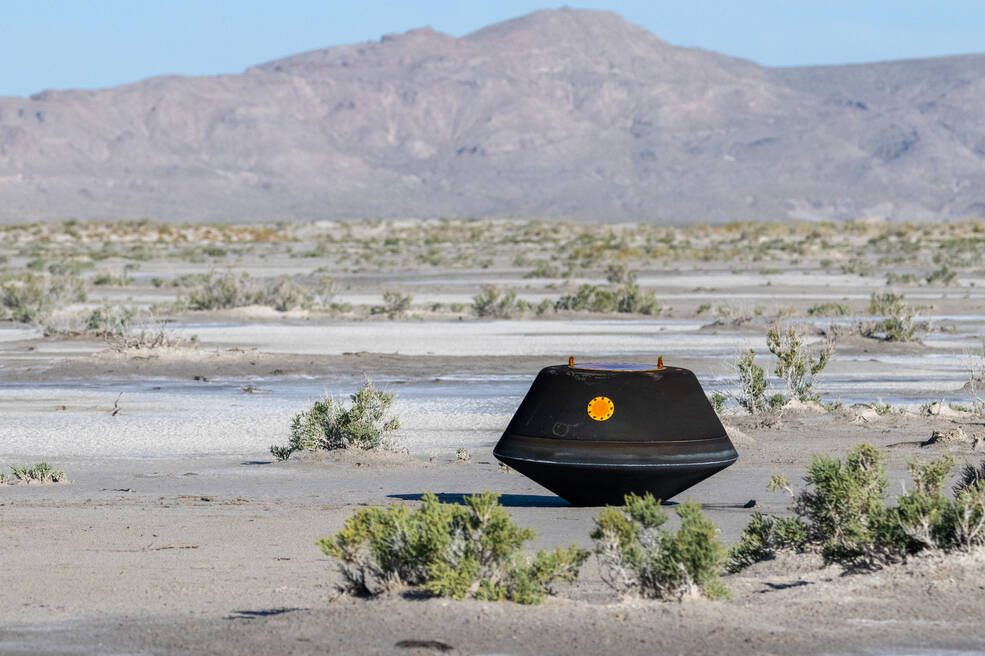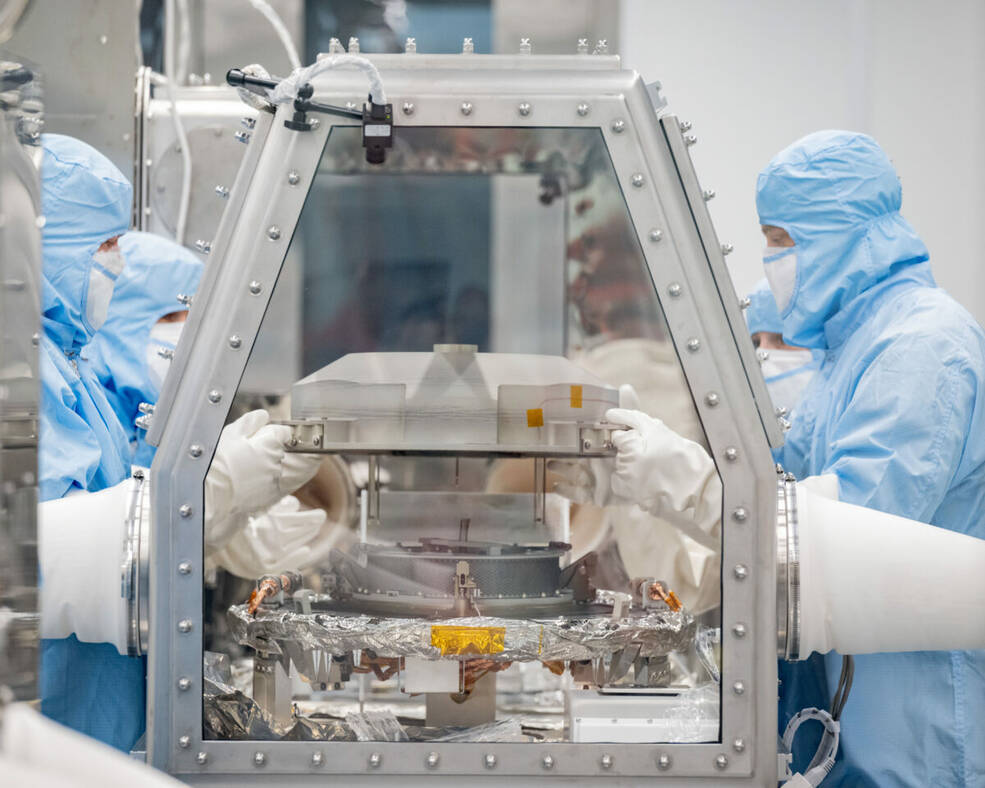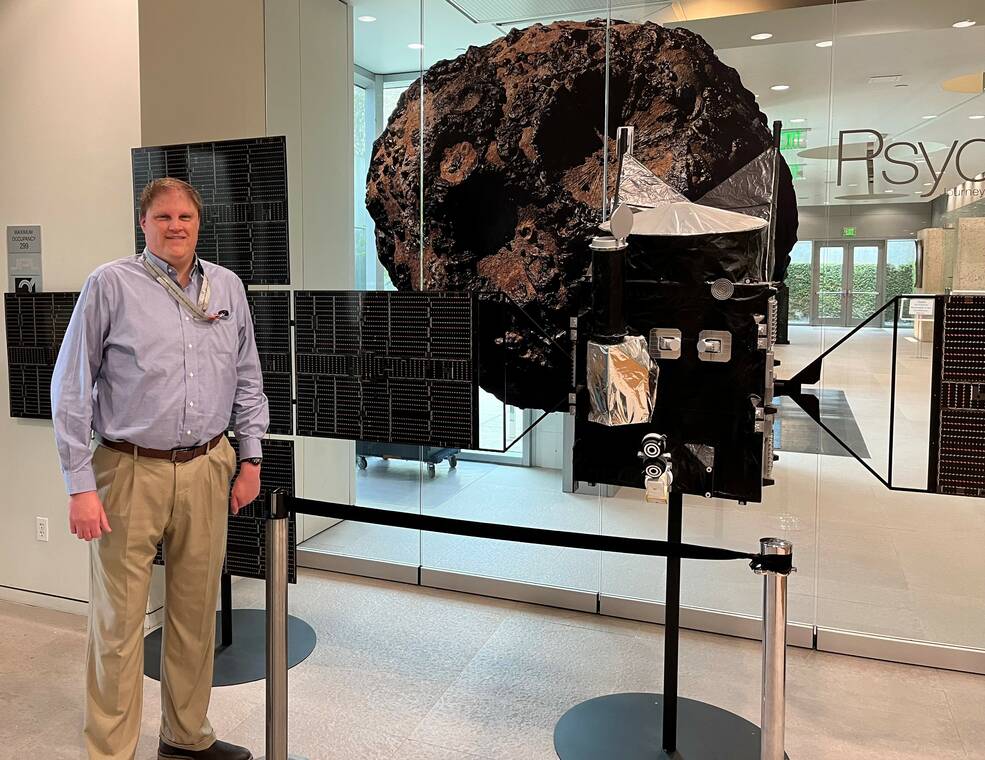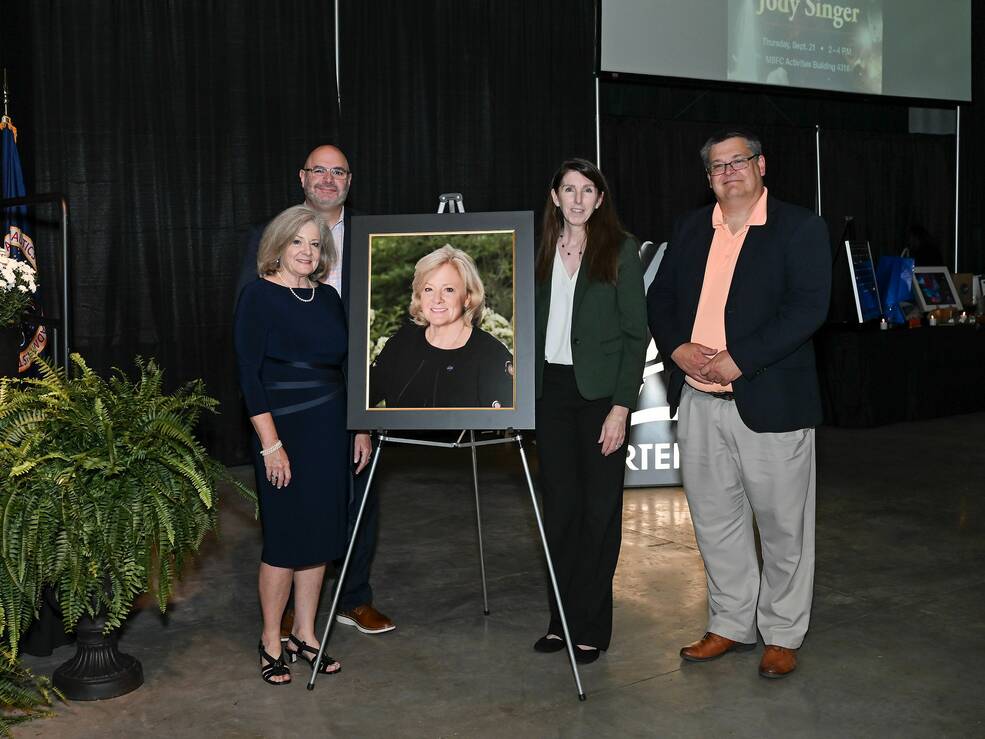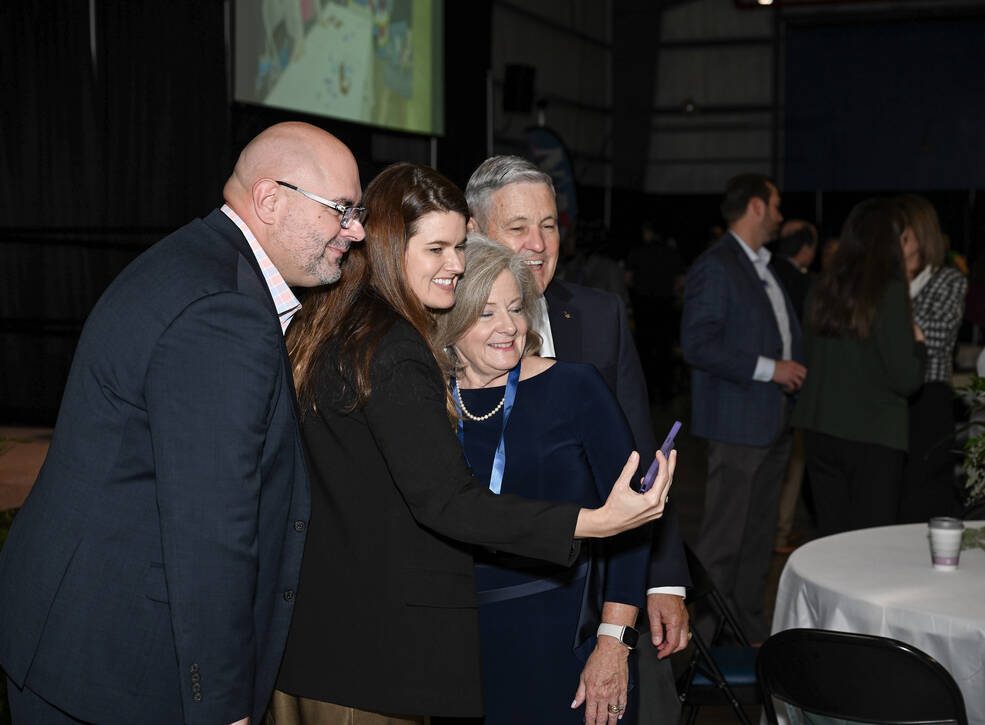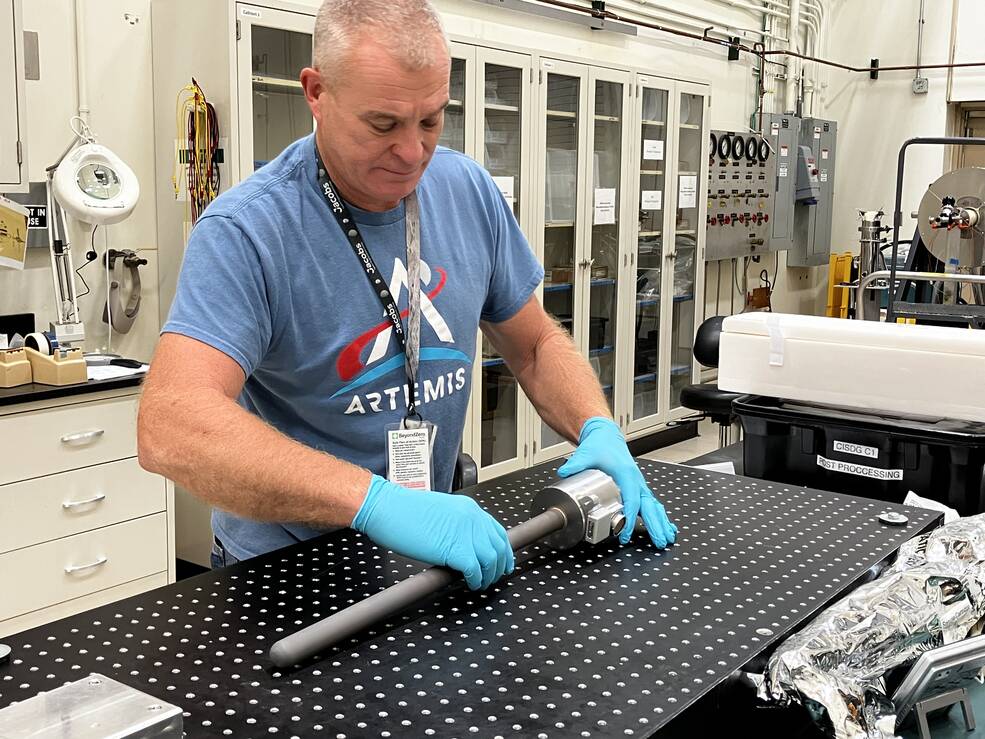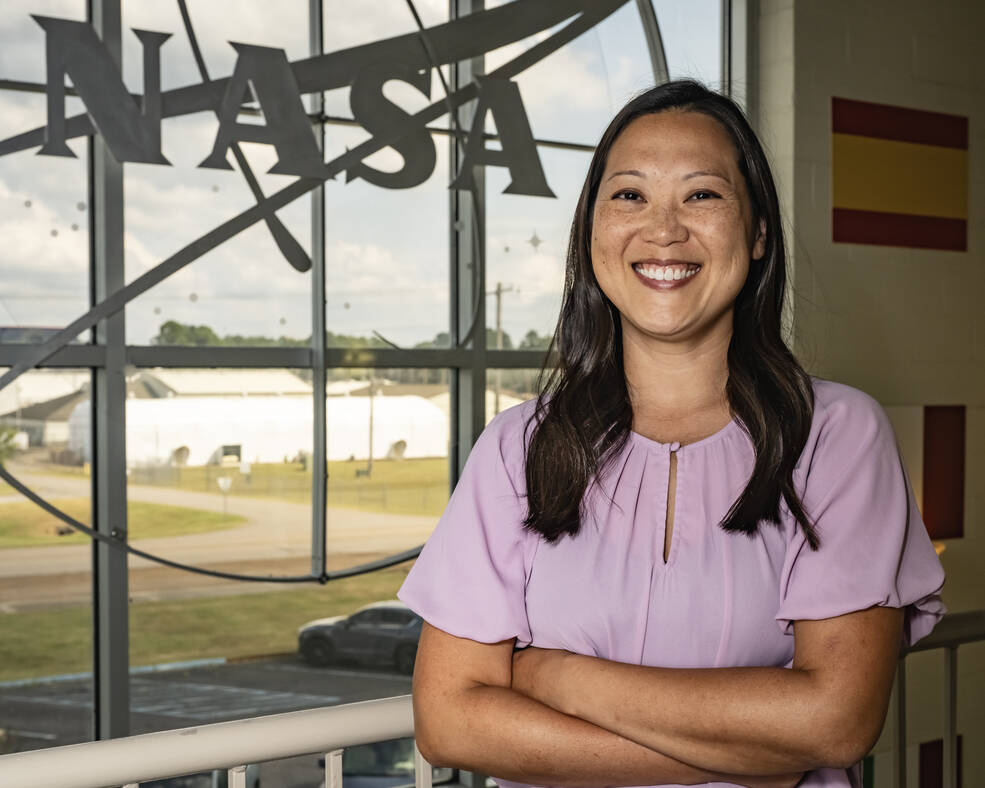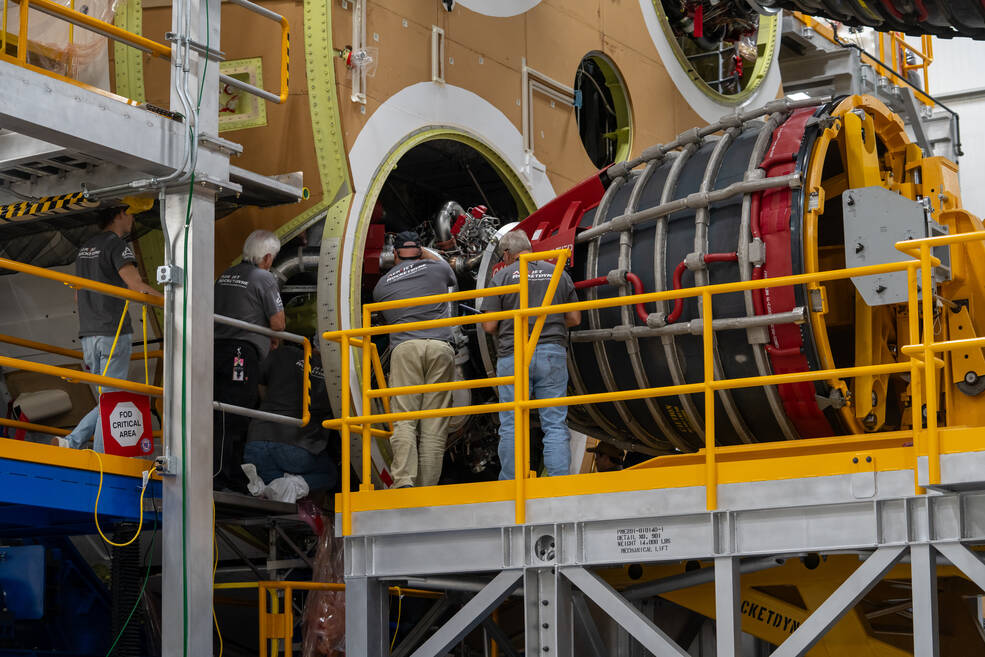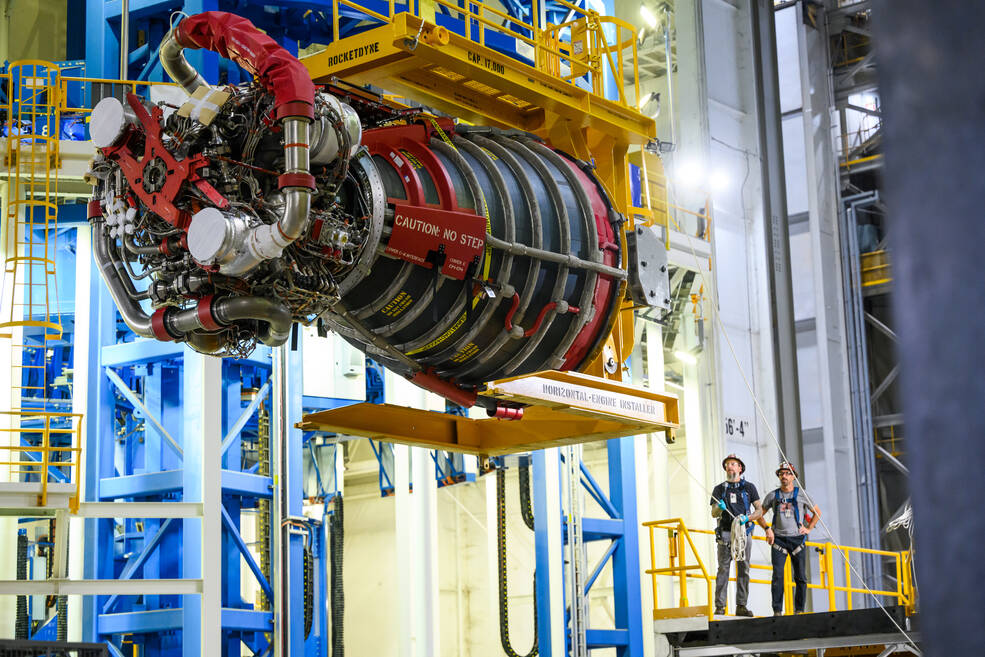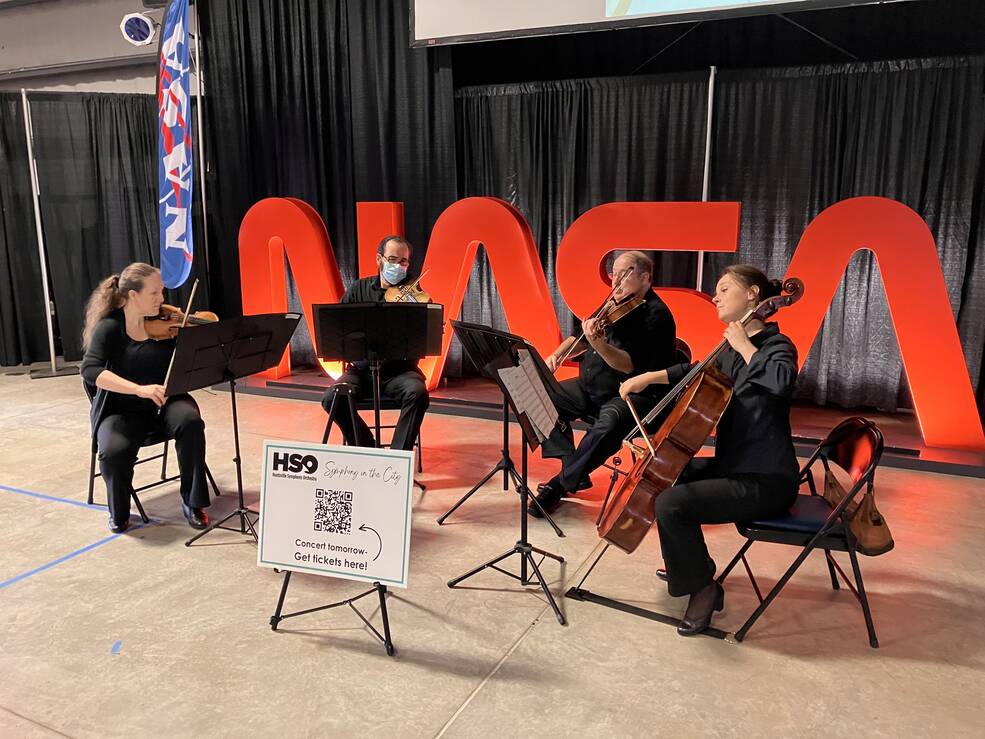The Marshall Star for September 27, 2023.
NASA’s First Asteroid Sample Has Landed
After years of anticipation and hard work by NASA’s OSIRIS-REx (Origins, Spectral Interpretation, Resource Identification and Security – Regolith Explorer) team, a capsule of rocks and dust collected from asteroid Bennu finally is on Earth. It landed at 9:52 a.m. CDT on Sept. 24, in a targeted area of the Department of Defense’s Utah Test and Training Range near Salt Lake City.
Within an hour and a half, the capsule was transported by helicopter to a temporary clean room set up in a hangar on the training range, where it was connected to a continuous flow of nitrogen.
Getting the sample under a “nitrogen purge,” as scientists call it, was one of the OSIRIS-REx team’s most critical tasks. Nitrogen is a gas that doesn’t interact with most other chemicals, and a continuous flow of it into the sample container inside the capsule will keep out earthly contaminants to leave the sample pure for scientific analyses.
The returned samples collected from Bennu will help scientists worldwide make discoveries to better understand planet formation and the origin of organics and water that led to life on Earth, as well as benefit all of humanity by learning more about potentially hazardous asteroids.
“Congratulations to the OSIRIS-REx team on a picture-perfect mission – the first American asteroid sample return in history – which will deepen our understanding of the origin of our solar system and its formation. Not to mention, Bennu is a potentially hazardous asteroid, and what we learn from the sample will help us better understand the types of asteroids that could come our way,” said NASA Administrator Bill Nelson. “With OSIRIS-REx, Psyche launch in a couple of weeks, DART’s one year anniversary, and Lucy’s first asteroid approach in November, Asteroid Autumn is in full swing. These missions prove once again that NASA does big things. Things that inspire us and unite us. Things that show nothing is beyond our reach when we work together.”
The Bennu sample – an estimated 8.8 ounces, or 250 grams – was transported in its unopened canister by aircraft to NASA’s Johnson Space Center on Sept. 25. Curation scientists there will disassemble the canister, extract and weigh the sample, create an inventory of the rocks and dust, and, over time, distribute pieces of Bennu to scientists worldwide.
NASA scientists found black dust and debris on the avionics deck of the OSIRIS-REx science canister when the initial lid was removed at Johnson on Sept. 26. Johnson houses the world’s largest collection of astromaterials, and curation experts there will perform the intricate disassembly of the TAGSAM (Touch and Go Sample Acquisition Mechanism) to get down to the bulk sample within. These operations are happening in a new laboratory designed specifically for the OSIRIS-REx mission. The aluminum lid was removed inside a glovebox designed to enable working with the large piece of hardware.
The delivery of an asteroid sample – a first for the U.S. – went according to plan thanks to the massive effort of hundreds of people who remotely directed the spacecraft’s journey since it launched on Sept. 8, 2016. The team then guided it to arrival at Bennu on Dec. 3, 2018, through the search for a safe sample-collection site between 2019 and 2020, sample collection on Oct. 20, 2020, and during the return trip home starting on May 10, 2021.
“Today marks an extraordinary milestone not just for the OSIRIS-REx team but for science as a whole,” said Dante Lauretta, principal investigator for OSIRIS-REx at the University of Arizona, Tucson. “Successfully delivering samples from Bennu to Earth is a triumph of collaborative ingenuity and a testament to what we can accomplish when we unite with a common purpose. But let’s not forget – while this may feel like the end of an incredible chapter, it’s truly just the beginning of another. We now have the unprecedented opportunity to analyze these samples and delve deeper into the secrets of our solar system.”
After traveling billions of miles to Bennu and back, the OSIRIS-REx spacecraft released its sample capsule toward Earth’s atmosphere at 5:42 a.m. The spacecraft was 63,000 miles from Earth’s surface at the time – about one-third the distance from Earth to the Moon.
Traveling at 27,650 mph, the capsule pierced the atmosphere at 9:42 a.m., off the coast of California at an altitude of about 83 miles. Within 10 minutes, it landed on the military range. Along the way, two parachutes successfully deployed to stabilize and slow the capsule down to a gentle 11 mph at touchdown.
“The whole team had butterflies today, but that’s the focused anticipation of a critical event by a well-prepared team,” said Rich Burns, project manager for OSIRIS-REx at NASA’s Goddard Space Flight Center. “For us, this was the World Series, ninth inning, bases-loaded moment, and this team knocked it out of the park.”
Radar, infrared, and optical instruments in the air and on the ground tracked the capsule to its landing coordinates inside a 36-mile by 8.5-mile area on the range. Within several minutes, the recovery team was dispatched to the capsule’s location to inspect and retrieve it. The team found the capsule in good shape at 10:07 a.m. and then determined it was safe to approach. Within 70 minutes, they wrapped it up for safe transport to a temporary clean room on the range, where it remains under continuous supervision and a nitrogen purge.
NASA Goddard provides overall mission management, systems engineering, and the safety and mission assurance for OSIRIS-REx. The University of Arizona, Tucson leads the science team and the mission’s science observation planning and data processing. Lockheed Martin Space in Littleton, Colorado, built the spacecraft and provides flight operations. Goddard and KinetX Aerospace are responsible for navigating the OSIRIS-REx spacecraft. Curation for OSIRIS-REx, including processing the sample when it arrives on Earth, will take place at NASA Johnson. International partnerships on this mission include the OSIRIS-REx Laser Altimeter instrument from CSA (Canadian Space Agency) and asteroid sample science collaboration with JAXA’s (Japan Aerospace Exploration Agency) Hayabusa2 mission.
OSIRIS-REx is the third mission in NASA’s New Frontiers Program, managed by NASA’s Marshall Space Flight Center for the agency’s Science Mission Directorate in Washington. Read more about Marshall’s role in OSIRIS-REx.
Countdown to Psyche: Marshall Aids Preparations for Asteroid Mission, Key Technology Payload
By Rick Smith
When the Psyche spacecraft lifts off Oct. 5 to rendezvous with a distant, metal-rich asteroid – and test an innovative new communications system on the way – management teams at NASA’s Marshall Space Flight Center will be watching keenly.
Psyche is the 14th planetary exploration mission in NASA’s Discovery program, which is managed for the agency by Marshall – as is the TDM (Technology Demonstration Missions) program, which funds the DSOC (Deep Space Optical Communications) project.
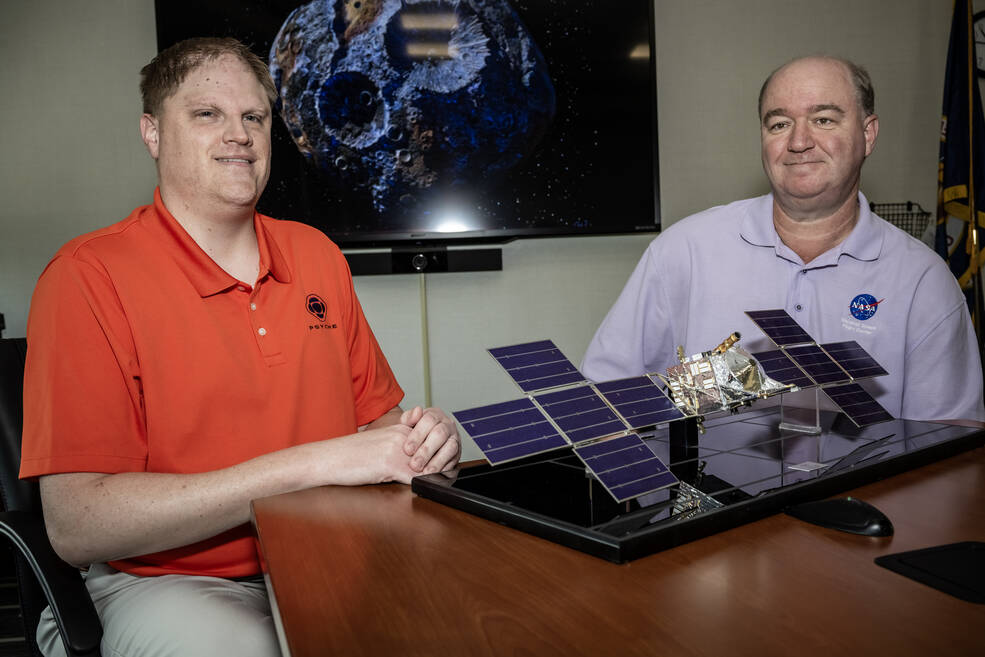
“We ensure the project teams have all the resources they need to execute the project, monitor costs and schedules to keep the project on track and on time, and work closely with the payload and launch teams throughout the flight mission,” said Brad Zavodsky, Psyche mission manager in Marshall’s Planetary Missions Program Office.
Joel Robinson, DSOC mission manager at Marshall, concurs. He and Zavodsky serve as “conduits,” he said, between directorate-level technology and science leadership at NASA Headquarters and the Psyche and DSOC project leadership – both of which, serendipitously, are managed at NASA’s Jet Propulsion Laboratory.
The program office teams at Marshall include program planning and control personnel, independent technical authorities, and procurement and acquisition specialists. These technical experts provide the Psyche and DSOC missions with all necessary guidance and direction throughout their respective development and programmatic life cycles.
“That means a number of presentations, weekly telecons, and periodic reviews,” Robinson said, “but it’s all worth it as we count down to launch. All that oversight helps facilitate delivery of a robust payload – one that’s ready for launch and ready to extend humanity’s reach into the solar system.”
Led by principal investigator Dr. Lindy Elkins-Tanton at Arizona State University, Psyche is set to be lofted to space on a SpaceX Falcon Heavy – the first interplanetary launch of that rocket – from NASA’s Kennedy Space Center at 9:34 a.m. CDT on Oct. 5.
Powered by solar electric propulsion, Psyche’s flight to the asteroid will take six years; it will reach its destination in 2029 and begin a 26-month period of scheduled scientific observations, gathering images and data to shed new light on the asteroid’s history and composition.
The Psyche asteroid, orbiting the Sun in the asteroid belt between Mars and Jupiter, measures roughly 173 miles at its widest point. Researchers are keen to determine whether it may have been the core of a planetesimal, part of an early planet.
“We know a good deal about Earth’s core, but we can’t study it directly because of its depth below the crust and mantle,” Zavodsky said. “Investigating Psyche is perhaps the closest we can come. Studying its composition and structure is an exciting opportunity to learn more about such objects in space – and perhaps a little something about our own planet as well.”
Should the Psyche spacecraft encounter challenges during flight, Zavodsky’s team will assist mission managers at JPL and Arizona State University, for whom Marshall oversees the project management and principal investigator contracts.
“We’ll maintain direct engagement with the project team and NASA decision-making authorities,” he said. “Should an issue arise, the project will be prepared to stand up anomaly response teams to understand and resolve those challenges. Our program office will support that effort as needed.”
Meanwhile, the DSOC technology demonstrator is set to pursue its own mission, sending and receiving test data from Earth using a near-invisible infrared laser and sensitive photon-counting camera. It will mark NASA’s farthest-ever test of high-bandwidth optical communications – paving the way for broadband communications when NASA sends astronauts to Mars.
“We’re tackling the twin issues of bandwidth and transmission rate to expand and refine our data-gathering ability from missions beyond the Moon,” Robinson said. “We can’t transmit data faster than the speed of light, but we can do far more with advanced optical systems of the same size and power requirements as traditional radio systems.”
Building on the Lunar Laser Communications Demonstration mission flown on the International Space Station in 2013 and the Laser Communications Relay Demonstration, launched to geostationary orbit above Earth in 2021, the DSOC effort is the first to experiment with ultra-long-range, laser-based communications.
“It’s exciting to take optical communications capabilities into deep space for the first time,” Robinson said. “DSOC could deliver 10 to 100 times the data current radio systems are capable of transmitting, with far greater precision and clarity.”
DSOC will test its optical transmission capabilities at and beyond a range of 1 astronomical unit, which is about 93 million miles – or the distance from the Sun to Earth. Psyche proves to be the perfect means to that end, requiring a gravity-assisting pass around the Sun in order to accelerate on its journey to the Psyche asteroid.
JPL laser researchers in California will send optical data to the DSOC payload during pre-conjunction – the period before the spacecraft is blocked by the Sun itself – and again during post-conjunction.
Smith, a Manufacturing Technical Solutions employee, supports the Marshall Office of Communications.
Take 5 with Brad Zavodsky
By Wayne Smith
Brad Zavodsky’s interest in science piqued at a young age. Growing up in Cincinnati, Ohio, both of his parents were teachers and they instilled in him a sense of curiosity about the world.
“My dad was a middle school science teacher and he was great at communicating science and helping others understand how the world works,” said Zavodsky, the mission manager of NASA’s Psyche asteroid mission for the Planetary Missions Program Office at Marshall Space Flight Center. “I like to say that working in the program office takes me back to being a student, staring in wonder at pictures of the planets in textbooks. Now, I get to work on projects that are re-writing those same books! I really enjoy sharing the planetary missions’ scientific discoveries with my family and giving back to those who first cultivated my scientific interest.”
The Psyche mission – a journey to a unique metal-rich asteroid orbiting the Sun between Mars and Jupiter – is scheduled to launch Oct. 5 on a Falcon Heavy from NASA’s Kennedy Space Center. What makes the asteroid Psyche unique is that it appears to be the exposed nickel-iron core of an early planet, one of the building blocks of our solar system. Psyche is part of NASA’s Discovery Program, also managed by Marshall.
Zavodsky’s sense of curiosity continues to drive him. He is also motivated and shares the enthusiasm of PIs (principal investigators) and science teams in the Planetary Missions program.
“Our PIs are extraordinary leaders in their scientific disciplines and have worked their whole careers to get to the point where they are leading a mission for NASA,” Zavodsky said. “It is exciting to be able to help them achieve their goals and objectives. Just being a small part of the revolutionary science data that our projects collect pushes me to do my best every day.”
Question: What are your primary responsibilities as program manager for the Psyche mission?
Zavodsky: I am responsible for ensuring the project has the resources necessary to successfully accomplish the mission. I am also responsible for overseeing the technical, cost, and schedule aspects of the project and ensuring that stakeholders within NASA are informed about any risks in those areas. The goal is to enhance the probability of mission success through providing this oversight. Additionally, I help the project navigate NASA processes and procedures, specifically the NASA Space Flight Program and project management requirements to confirm that they are compliant with all the necessary requirements to prepare them for gate reviews and decisional meetings.
Question: What excites you most about the future of human space exploration and your team’s role in it?
Zavodsky: The planetary bodies we target are unique, and many times, the first time humans have visited a location in our solar system. Psyche is humanity’s first visit to a metal asteroid. We have visited rocky bodies like Mercury and asteroids, icy bodies like comets, and gas bodies like Jupiter and Saturn, but this will be the first time we have visited a metal body. One of Psyche’s objectives is to identify whether the Psyche asteroid is a remnant planet core like Earth’s core, which could teach us about the early history of our own planet. Some of our other projects are targeting Jupiter’s moon, Europa, and Saturn’s moon, Titan, to identify environments that may sustain or once may have sustained life. It is exciting to have a front row seat for these types of exploration projects that are helping to solve some of humanity’s longest-standing questions about the universe.
Question: What has been the proudest moment of your career and why?
Zavodsky: I had the opportunity to support the acquisition process for the 2019 Discovery Program Announcement of Opportunity. I assisted the program scientist in preparing the panels that reviewed the various mission concepts, managing the review process, and communicating the results of the review to decision makers at NASA Headquarters. Being in that role allowed me to participate in several decisional meetings at headquarters, which provided incredible insight into how NASA selects missions and the types of programmatic considerations that are required when making such decisions. This Announcement of Opportunity ultimately led to the selection of the DAVINCI (Deep Atmosphere Venus Investigation of Noble gases, Chemistry, and Imaging) and VERITAS (Venus Emissivity, Radio Science, InSAR, Topography, and Spectroscopy) missions to Venus, the first NASA missions to our neighbor planet in over three decades. When those missions were announced by the NASA administrator, I was extremely proud to have played a role in the process.
Question: What advice do you have for employees early in their NASA career or those in new leadership roles?
Zavodsky: When presented with new work or training opportunities, say yes. Trust that your supervisor is putting you in a position to learn a valuable skill and setting you up to succeed. If you are not getting those opportunities, communicate to your supervisor about your willingness to learn new skills or try a new role. Taking stretch assignments or accepting a new role can be intimidating, but every job requires some on-the-job training, so you can never expect to be an expert on day one. While you may not feel like you have all the experience needed, if you identify others who have experience, establish good relationships, and ask lots of good questions, you can accomplish anything.
Question: What do you enjoy doing with your time while away from work?
Zavodsky: I enjoy watching sports during my time away from work. Having grown up in Cincinnati, I am a lifelong Cincinnati Reds, Cincinnati Bengals, and University of Cincinnati Bearcats basketball fan. Since moving to Huntsville in 2005, I have also become a big University of Alabama football fan.”
Smith, a Media Fusion employee and the Marshall Star editor, supports the Marshall Office of Communications.
Marshall Bids Farewell to Former Center Director with Retirement Ceremony
By Jessica Barnett
Hundreds filled Activities Building 4316 on Sept. 21 to offer their best wishes to former NASA Marshall Space Flight Center Director Jody Singer as she takes on her next big adventure: retirement.
Marshall team members brought gifts, recorded messages, and lined up for a hug or handshake with Singer as part of the celebration. A select few were invited to stand on stage and speak about Singer’s many career accomplishments, as well as how deeply she would be missed.
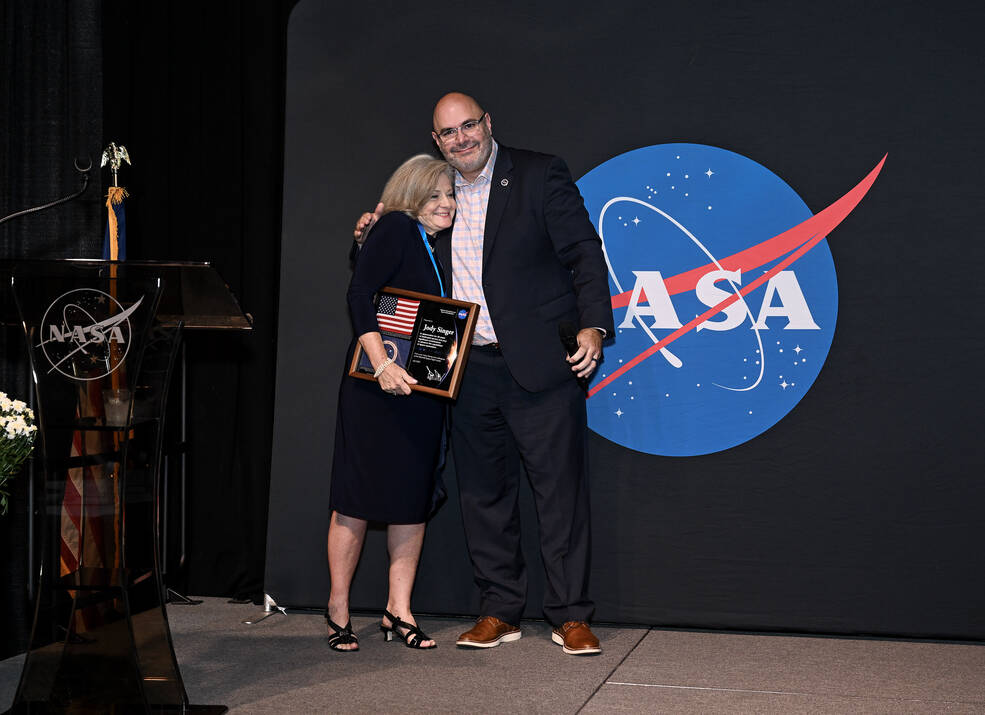
“We have SLS (Space Launch System) in part because of the hard work of Jody, and that’s pretty amazing,” said NASA Associate Administrator Bob Cabana. “All that she did led up to her being the deputy director at Marshall, and from there, an amazing five-year tenure as the director.”
Singer joined NASA in 1985 as an engineer and then supported the Space Shuttle program in 1986. In all, she was involved in 110 shuttle missions. She was named the first female project manager for the Reusable Solid Rocket Booster Project in 2002 and was holding three deputy positions simultaneously just eight years later.
Eight years after that, in 2018, she became Marshall’s first female center director, overseeing 7,000 employees, a $5 billion budget, and one of NASA’s largest field installations. Singer retired July 29.
Joseph Pelfrey, who took over as Marshall’s acting center director, said he’s learned just how heavy a load Singer carried in his few weeks in the role.
“It can’t be overstated the impact that Jody had on our center, on our agency, and especially me, personally,” Pelfrey said. “To believe in me, to believe in the people that followed you – it’s your way of paying it forward, as you always said, and it can’t be overstated how much we appreciate that.”
Singer received numerous awards during her 38-year career with NASA, and the recognition continued at her retirement ceremony. Cabana joined NASA Deputy Associate Administrator Casey Swails in presenting Singer with the Distinguished Service Medal, NASA’s highest honor, along with pins from 68 International Space Station missions, plus an Alabama flag and U.S. flag that flew on the Orion spacecraft for Exploration Flight Test-1 and Artemis I.
Pelfrey, along with Marshall Associate Director, Technical, Larry Leopard, who emceed the ceremony, presented Singer with a plaque honoring her time at Marshall. The plaque was made with wood from Building 4200, which Singer decided to have demolished during her tenure, and flags that flew on the last Challenger mission and Artemis I.
“Jody has inspired countless young people, especially young women, to pursue careers in STEM, and she has personally dedicated her career to mentoring the next generation of explorers and leaders,” Leopard said. “I can personally say she left Marshall better than she found it.”
‘Who we are’
When it was her turn at the microphone, Singer offered thanks to the long list of team members-turned-friends she has worked with and received support from over the years.
“It makes a big difference, having folks you can call up and rely on,” she said. “You can’t do it by yourself. It has to be a team, and I couldn’t have had better partners in this journey.”
She said despite multiple reassurances that she would know when the time was right to retire, the decision was far from easy.
“I’m not a quitter, and I love what we do,” Singer said. “I love the passion for our mission, I love all the folks, and it’s really, really hard to decide when it is time. But then I look around and I see the teams, I see the leadership we have, and when you see such talent and passion, and knowing there are people that could do it a lot better than I ever thought about doing it, that’s when I know it’s time.”
Singer said she’s looking forward to seeing what Marshall accomplishes under the next director’s leadership, and she offered this bit of advice to team members:
“Don’t forget who we are at Marshall. Where else can you say you’re a center that launches, you land, you live in space, you help people learn, you have science, leading-edge technology and manufacturing? There is nothing wrong with being proud of the expertise that Marshall brings to the game. It just doesn’t get any better.”
Meanwhile, she added, “I’ll always be counting on you, fighting for you, and most of all, being so proud to be part of a team like this.”
Barnett, a Media Fusion employee, supports the Marshall Office of Communications.
Marshall Teams Combine to Make Space Station Science Reality
By Gina Hannah and Jonathan Deal
For more than 20 years, astronauts aboard the International Space Station have worked diligently on science experiments that benefit humanity on Earth and in deep space. Getting these experiments to and from space is a multi-faceted effort across the agency. Teams at NASA’s Marshall Space Flight Center have combined their world class capabilities – before and after these experiments return from the space station – to make that cutting-edge science a reality.
One experiment that recently returned from station is a perfect example of how the teams work together. The experiment titled “Growth of Ternary Compound Semiconductors” seeks to study crystal growth in microgravity, specifically focusing on ZnSe (zinc selenide) compounds and one of their potential applications in high-powered lasers operating in the infrared wavelengths.
Six SCAs (Sample Cartridge Assemblies) launched to the space station as part of the SpaceX Commercial Resupply Service Mission-24. Using the Materials Science Laboratory on station, it aimed to cultivate crystals of zinc selenide, zinc selenide telluride, and chromium-doped zinc selenide using the physical vapor transport method. But what set this experiment apart was its core objective: to discern how gravity-driven fluid flows influenced the structural, electrical, and optical characteristics of these crystals when compared to their counterparts grown on Earth.
As the crystals began to form, scientists, personnel from space station project office, and the thermal team of Marshall’s Test Lab, monitored their progress. In the unique environment of microgravity, fluid dynamics took on a new dimension, and the crystals flourished under those conditions.
“Without gravity, we have better control because weight itself can cause defects and affect the growth pattern,” said Dr. Ching Hua Su, the experiment’s principal investigator. “Our main goal is to study the effect of gravity on vapor transport crystal growth. When dealing with materials that melt at higher temperatures, vapor growth lowers the temperature and contributes fewer defects. That’s why we chose zinc selenide for our applications.”
Su is a member of the Materials Science and Metallurgy Branch in Marshall’s Materials and Processing Lab. That team also works on the engineering projects ranging from additive manufacturing, welding to metallurgy for fuel tanks and engines.
On Earth, quality ZnSe-based crystals are used in various optical applications, with implications for cutting edge-technologies such as optical windows, infrared lasers, and optical wavelength conversion devices. Being able to conduct the experiment in a microgravity environment, scientists have gained insights that could enhance the quality of these crystals, thus paving the way for revolutionary advances in optical technology.
“We are now on the brink of completing our sixth flight experiment,” Su said. “We are eager to compare our space-grown samples with those from the ground, conducting two more runs on this duplicate furnace in the test lab at Marshall to facilitate direct comparisons.”
Ensuring the science conducted on the payload is successful is a team effort, and work on the mission begins years before the payload launches.
“We have a payload operation integration specialist and a payload activity requirement coordinator who work with the payload developer to write procedures and document timing constraints,” said Jennifer McMillian, payload operations manager for the International Space Station Increment 69 management team.
Those procedures include determining the length of the experiment, proper installation of the cartridge, and defining the type of ground support needed. Planners then work those activities into the mission timeline so the payload can be scheduled into the workflow on the Materials Science Research Rack after it arrives on the space station.
Scheduling the work takes into consideration both crew time and station resources, including power, water, and the vacuum exhaust system.
“We’re involved in all of the planning. We have the whole increment team that is working on building a plan, say, six months out, and then refining that plan daily as we get closer to execution,” McMillian said.
Once the payload enters the rack, the team’s work is round-the-clock.
“When we get to real-time execution, the payload rack officers here are responsible for commanding to the rack, applying all of the resources to that rack to enable the science,” she said.
The astronauts will use the instructions written by the payload operations integration specialist to process the run, usually for about a week. The process is repeated for each of the samples in the payload before being returned to Earth.
The work is an international effort. As payloads are being processed, a team at Marshall monitors the rack, and a European Space Agency team in Munich, Germany, adjusts parameters for each specific investigation in the rack, McMillian said.
“When we’re in the middle of execution, we’re in the monitoring phase, and react to any anomalous situation we may see,” she said.
With the crystals now back on Earth, Su and his team are hoping the experiment will lead to new frontiers in crystal growth and the endless possibilities it holds for both space and terrestrial applications.
Hannah, a Media Fusion employee, supports Marshall’s Office of Communications and Strategic Analysis, and Deal, a public affairs officer, supports the Marshall Office of Communications.
Eleasa Kim: Supporting NASA’s Commercial Low-Earth Orbit Development Program
For Eleasa Kim, being part of NASA’s Commercial Low-Earth Orbit Development Program, also known as CLDP, is the perfect combination of working with technology and helping people.
As the payload project integrator for CLDP supporting NASA Marshall Space Flight Center’s Human Exploration Development and Operations Division, Kim supports NASA and commercial entities that want to be part of the agency’s burgeoning commercial low Earth orbit economy.
As NASA works to transition science operations from the International Space Station to commercial space stations, Kim is working to ensure a smooth transition for the science being conducted in microgravity for the benefit of humanity.
“What inspires me every day is being trusted by CLDP and Marshall to represent payloads operations in these critical stages of commercial space station development,” Kim said. “I get a front row seat as I offer my expertise and passion to help further this mission in making the spaceflight team operating in low Earth orbit even bigger and more sustainable with commercial partnerships.”
Kim’s path to NASA began with an aptitude test taken at her high school in Opelika, Alabama, that revealed she would do well working in public service. She also enjoyed anatomy and biology classes and had an interest in technology. During her sophomore year, a teacher suggested she would make a great engineer. Stem cell research was beginning to make headlines, and she decided to pursue her bachelor’s degree in biomedical engineering at Vanderbilt University.
She also earned a master’s degree in biotech research from Northwestern University. When evaluating the next step in her journey, she evaluated Ph. D. programs and industry jobs.
“I love people, technology, and teams – working on a team and having a shared goal,” Kim said. “And I like results.”
In 2007, Kim landed a job on a NASA contract at Johnson Space Center, working for Wyle Laboratories as a biomedical engineer flight controller in Mission Control supporting the hardware for astronauts in space.
“Until then, NASA had not been on my radar at all, but I thought, ‘Wow, that’s a cool opportunity,’ and it aligned with those things that are most fulfilling to me,” she said.
Kim supported the operations for crew health and medical equipment on the space station. This included medications, exercise hardware, and environmental sampling equipment. For Space Shuttle mission STS-119 and Increments 27 and 28, she managed the full mission complement of activities and hardware resupply and return. She also trained new biomedical engineer flight controllers.
“It was very hard, but I love challenges and working hard,” Kim said. “And I like working on a team. And that’s exactly what it was. It had the hardware side of things – the building and fixing of things, because the space station was being assembled and hardware rarely works exactly how you think it will in microgravity. And it also had the human aspect of supporting crew health.”
Kim joined the Marshall team in 2014 and has worked as a science payload planner for station and worked a short time on the safety team supporting payloads for the Artemis I mission. She also did systems integration for the Microgravity and Life Science Glovebox teams. After working on various support contracts for about 15 years, she was hired by NASA as a civil servant in 2020. During the first few years as a civil servant, Kim provided technical leadership for the mission planning branch of the Payload and Mission Operations Division at Marshall. While in this role, one of the part-time tasks she fulfilled was providing subject matter expert support for CLDP. In spring of this year, that part-time role became a full-time position.
Kim said she is looking forward to seeing the commercial low Earth orbit economy develop in the years to come. NASA is working with commercial teams to develop commercial space stations and the services that will be needed to support them.
“When the space station retires, the plan is for us to continue to fly and get our astronauts experience in microgravity and low-Earth orbit as well as execute science in microgravity and low-Earth orbit,” she said. “We want to be one of many users of commercial space stations.
“What I’m most excited for now is that NASA is leveling up by supporting the creation of commercial space stations and destinations. I have a lot of passion for our mission – me in this role is where I’m meant to be right now.”
All Engines Added to NASA’s Artemis II Moon Rocket Core Stage
Teams at NASA’s Michoud Assembly Facility have structurally joined all four RS-25 engines onto the core stage for NASA’s Artemis II Moon rocket. The flight test is the agency’s first crewed mission under Artemis.
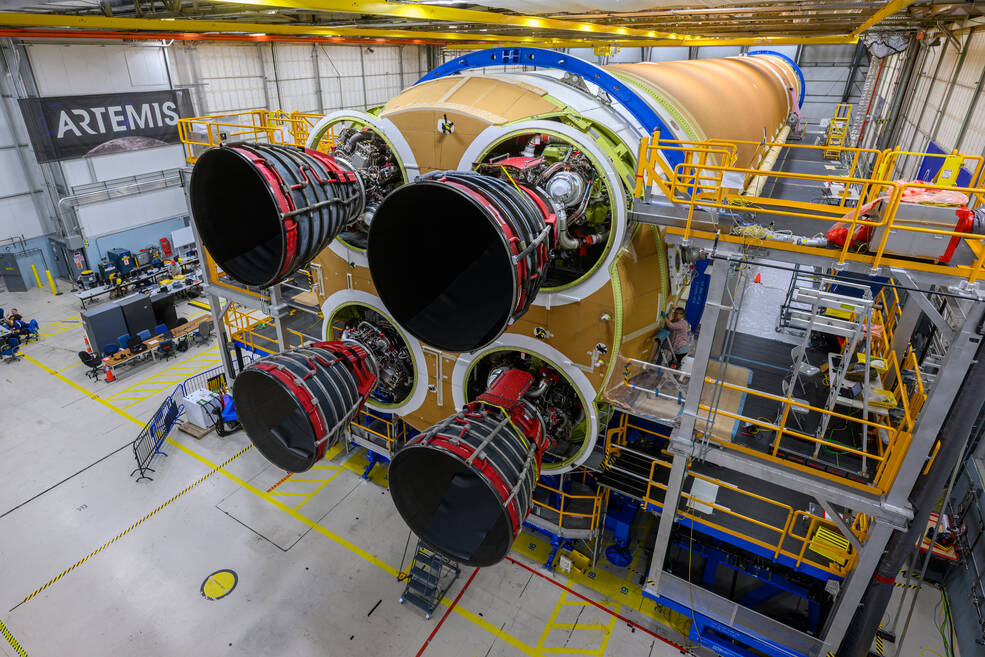
Technicians added the first engine to NASA’s SLS (Space Launch System) rocket core stage Sept. 11. Teams installed the second engine onto the stage Sept. 15 with the third and fourth engines Sept. 19 and Sept. 20. Technicians with NASA, Aerojet Rocketdyne, an L3Harris Technologies company and the RS-25 engines lead contractor, along with Boeing, the core stage lead contractor, now will focus efforts on the complex task of fully securing the engines to the stage and integrating the propulsion and electrical systems within the structure.
The SLS core stage, at 212 feet, is the backbone of the Moon rocket. Its two huge propellant tanks provide more than 733,000 gallons of super-chilled liquid propellant to the four RS-25 engines, while the stage’s flight computers, avionics, and electrical systems act as the “brains” of the rocket. During Artemis II, the RS-25 engines will together provide more than 2 million pounds of thrust for eight minutes of flight, helping to send the Artemis II crew beyond low-Earth orbit to venture around the Moon.
NASA is working to land the first woman and first person of color on the Moon under Artemis. SLS is part of NASA’s backbone for deep space exploration, along with Orion and the Gateway in orbit around the Moon, and commercial human landing systems. SLS is the only rocket that can send Orion, astronauts, and supplies to the Moon in a single mission.
NASA’s Marshall Space Flight Center manages the SLS Program.
Artemis II SLS Rocket Booster Segments Arrive at Kennedy Space Center
The 10 booster motor segments for NASA’s SLS (Space Launch System) rocket that will help propel the Artemis II astronauts on a trip around the Moon arrived at the agency’s Kennedy Space Center on Sept. 25. They will form the SLS rocket’s twin, five-segment solid rocket boosters, which produce more than 75% of the total thrust at liftoff, to send NASA’s Artemis missions to the Moon.
Due to their weight, the 10 booster motor segments traveled by rail across eight states in specialized transporters to the spaceport. Teams with NASA’s Exploration Ground Systems Program now are preparing to process each of the segments inside the space center’s Rotation, Processing and Surge Facility ahead of integrating them inside the Vehicle Assembly Building.
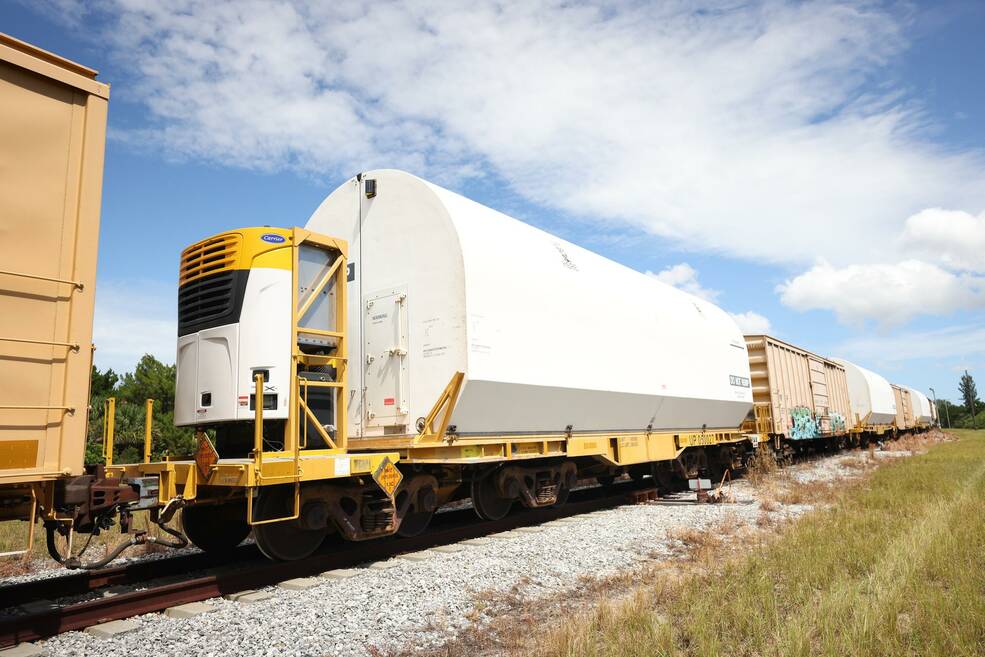
“The arrival of the SLS solid rocket booster motor segments is an important turning point as NASA and our Artemis partners begin readying for stacking and launch preparations for Artemis II,” said Amit Kshatriya, deputy associate administrator for the Moon to Mars Program Office at NASA Headquarters. “Fully stacked, these boosters for NASA’s SLS rocket are the largest, most powerful ever built for spaceflight and will help send the first astronauts around the Moon in more than 50 years.”
Manufactured by SLS booster lead contractor Northrop Grumman in Utah, the SLS solid rocket boosters have three major assemblies with the motor segment being the largest portion of the booster. Teams will inspect them along with the forward and aft skirt assemblies of the boosters. They will then rotate the segments to a vertical position in preparation for stacking operations for Artemis II. The top and bottom portions of the boosters were previously assembled in the Booster Fabrication Facility at Kennedy.
Ten booster motor segments for NASA’s SLS (Space Launch System) rocket were loaded into specialized transporters at Northrop Grumman’s facility in Promontory Point, Utah, for a cross-country rail trip to NASA’s Kennedy Space Center in Florida in September. The booster motor segments, which each weigh 180 tons, traveled across eight states and arrived at the spaceport Sept. 25. Crews at Kennedy will use the segments to build the two SLS solid rocket boosters that will provide more than 75% of the total thrust for the agency’s crewed Artemis II mission. Northrop Grumman is the lead contractor for SLS boosters, which are the largest and most powerful ever built for spaceflight. NASA’s Marshall Space Flight Center manages the SLS Program.Credits: NASA
Once processing is complete, crews will move all the major segments one at a time to the Vehicle Assembly Building where they will get stacked to form each of the 17-story-tall boosters that flank each side of the rocket. Following completion, engineers and technicians will integrate the rocket’s core stage. Together, the SLS rocket’s twin boosters and the core stage’s four RS-25 engines produce more than 8.8 million pounds of thrust.
NASA’s Marshall Space Flight Center manages the SLS Program.
Artemis II is the first crewed Artemis mission and will test all the Orion spacecraft’s systems with NASA astronauts Reid Wiseman, Victor Glover, and Christina Koch, along with Canadian Space Agency astronaut Jeremy Hansen, aboard before future missions to the Moon.
Historic Wind Tunnel Facility Testing NASA’s Mars Ascent Vehicle Rocket
By Jessica Barnett
The MAV (Mars Ascent Vehicle) team recently completed wind tunnel testing at NASA’s Marshall Space Flight Center in a facility that has been a critical part of NASA missions going all the way back to the Apollo program.
The same facility that provided valuable testing for NASA missions to low-Earth orbit and the Moon is now helping the agency prepare to launch the first rocket from Mars. The MAV is an important part of the joint plan between NASA and ESA (European Space Agency) to bring scientifically selected Martian samples to Earth in the early 2030s.
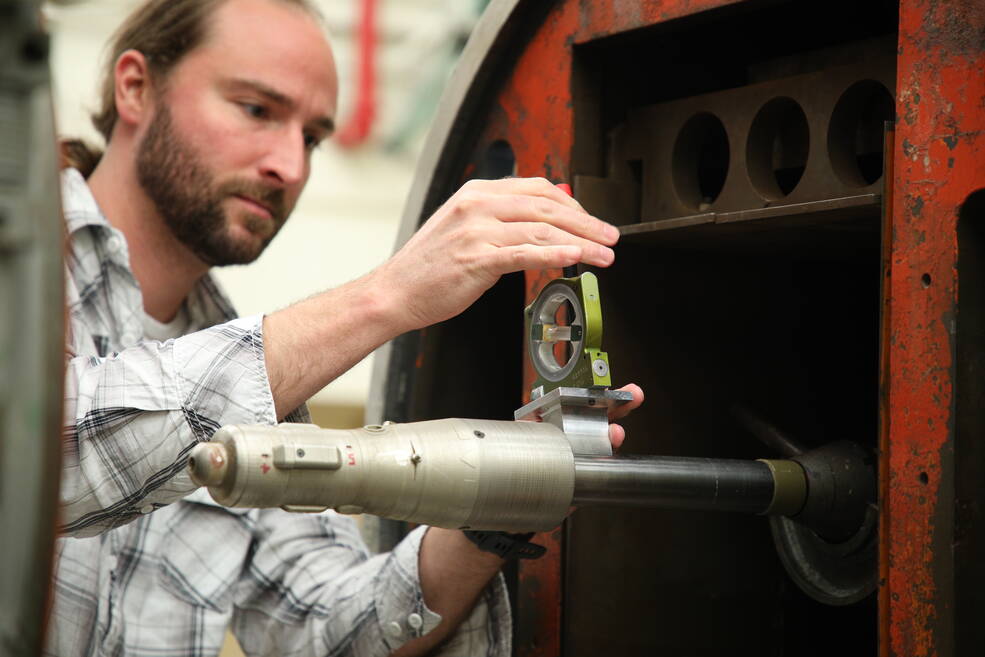
The testing took place July 10 –15 and allowed the team to gather aeroacoustic data to help them understand the dynamics of MAV’s design using 3D-printed scale models.
“With these successful tests, we are improving our understanding of MAV aerodynamics, integrated performance, controllability, and vehicle loading,” said MAV Project Manager Steve Gaddis. “We will use the results to inform our design and make any needed improvements for the robust MAV needed to deliver Martian rock samples to orbit.”
The test section of Marshall’s wind tunnel is only 24 inches long and 14 inches in height and width. However, it can achieve supersonic speeds of up to Mach 5 (about 3,800 mph) and has a long history of testing iconic rockets, including Redstone, Jupiter-C, and Saturn, as well as Space Shuttle and SLS (Space Launch System) designs.
MAV aeroacoustics lead Annie Catherine Barnes, who served as co-lead for the July testing campaign, said the team tested scale models at multiple angles inside the wind tunnel to see how air flow might affect MAV’s structure. Barnes compared it to turbulence on an airplane.
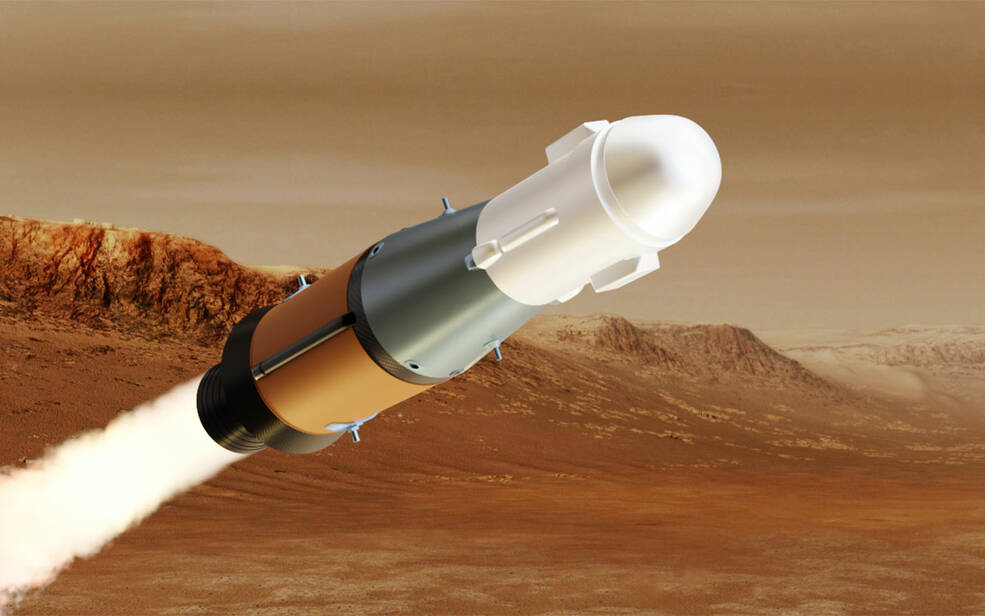
“We’re looking for areas of turbulent flow for launch vehicles,” she said. “We’re looking for shock oscillations and large areas of pressure fluctuation that can cause a structural response.”
The team will use data from the July testing campaign and other analyses to form a better estimate of the environments MAV would face as it becomes the first vehicle to launch from the surface of another planet.
MAV supports the planned Mars Sample Return campaign, which would bring scientifically selected samples to Earth for study using the most sophisticated instrumentation around the world. This strategic partnership with ESA is developing the technology and the preliminary designs for missions that would accomplish the first return samples from another planet. The samples currently being collected by NASA’s Perseverance rover during its exploration of an ancient river delta have the potential to reveal the early evolution of Mars, including the potential for ancient microbial life.
y
A scale model of the Mars Ascent Vehicle is tested for in the trisonic wind tunnel at Marshall. The tunnel’s test sections are only 14 inches in height and width but can achieve wind speeds of up to Mach 5.Credits: NASA
Managed at Marshall, the MAV would launch aboard the Sample Retrieval Lander from Earth for a two-year journey to Mars. It would remain on the surface of Mars for nearly a year of receiving the samples collected by Perseverance.
After the Sample Transfer Arm on the lander loads the samples into a container in the rocket, MAV would launch from Mars into orbit around the planet, releasing the sample container for the ESA-developed Earth Return Orbiter to capture.
The samples are targeted to arrive on Earth in the early 2030s. The Mars Sample Return Program is managed by NASA’s Jet Propulsion Laboratory in Southern California.
Barnett, a Media Fusion employee, supports the Marshall Office of Communications.
Huntsville Symphony String Quartet Performs at Marshall
By Jessica Barnett NASA Marshall Space Flight Center team members were treated to a special 30-minute performance by musicians from the Huntsville Symphony Orchestra inside Activities Building 4316 on Sept. 21.
The string quartet included two violinists, a violist, and a cellist performing several recognizable classical compositions, including Gershwin’s “Summertime” and Mouret’s “Rondeau.”
The performance was part of “Symphony in the City,” an educational and outreach campaign providing free live performances throughout North Alabama. The string quartet performed earlier that afternoon inside the Java Café for Redstone Arsenal personnel.
The Huntsville Symphony Orchestra originally began performing in 1955 and today serves as a 501(c)(3) nonprofit organization offering concerts, educational programs and more with leading musicians from around the world.
Barnett, a Media Fusion employee, supports the Marshall Office of Communications.





























